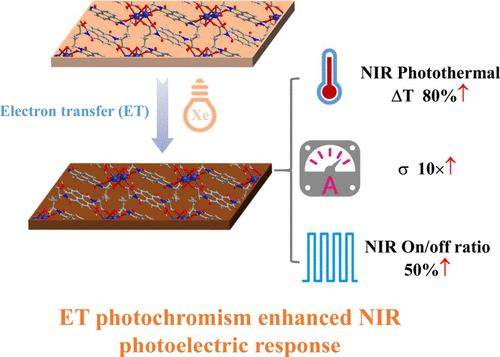半导体配位聚合物中增强近红外光电响应的电子转移光致变色
IF 4.7
2区 化学
Q1 CHEMISTRY, INORGANIC & NUCLEAR
引用次数: 0
摘要
近红外(NIR)光电材料因其在生物医学成像、夜视和健康监测方面的广阔潜力而受到越来越多的关注。配位聚合物(CPs)具有可调的结构和功能,是这一领域中很有前途的候选者。然而,具有高效近红外光电响应的CPs仍然有限。本文报道了一种由缺电子萘二亚胺(NDI)衍生物构成的光致变色配位聚合物[K(HAlaNDI)]n(1)。在氙灯照射下,化合物1呈现出明显的由浅棕色到深棕色的颜色变化,同时出现较宽的吸收带和较强的EPR信号。经过光照射后,1的近红外光热转换性能显著增强,表面温升(ΔT)提高了约80%。同时,1的电导率增加了近一个数量级,在30°C时从7.24 × 10-9增加到6.19 × 10-8 S/cm。这些增强可能主要归因于稳定电荷分离态(NDI·-)的产生。因此,1的彩色形式表现出显著增强的近红外光电响应,在很宽的功率密度范围内,开/关比增加了50%以上,突出了电子转移型光致变色是提高近红外光电性能的有效策略。本文章由计算机程序翻译,如有差异,请以英文原文为准。

Electron-Transfer Photochromism for Enhanced Near-Infrared Photoelectric Response in a Semiconductive Coordination Polymer
Near-infrared (NIR) photoelectric materials have garnered increasing attention due to their broad potential in biomedical imaging, night vision, and health monitoring. Coordination polymers (CPs), with tunable structures and functionalities, have emerged as promising candidates in this area. However, CPs exhibiting efficient NIR photoelectric response remain limited. Herein, we report a photochromic coordination polymer [K(HAlaNDI)]n (1), constructed from an electron-deficient naphthalenediimide (NDI) derivative. Upon Xe lamp irradiation, compound 1 exhibits distinct color change from light brown to deep brown, accompanied by the emergence of broad absorption bands and a strong EPR signal. After photoirradiation, the NIR photothermal conversion performance of 1 was significantly enhanced, with the surface temperature rise (ΔT) increasing by approximately 80%. Concurrently, the electrical conductivity of 1 increased by nearly an order of magnitude, from 7.24 × 10–9 to 6.19 × 10–8 S/cm at 30 °C. These enhancements could be primarily ascribed to the generation of stable charge-separated states (NDI·–). As a result, the colored form of 1 exhibits significantly enhanced NIR photoelectric response, with the on/off ratio increasing by over 50% across a wide range of power densities, highlighting electron-transfer-type photochromism as an effective strategy for improving NIR photoelectric performance.
求助全文
通过发布文献求助,成功后即可免费获取论文全文。
去求助
来源期刊

Inorganic Chemistry
化学-无机化学与核化学
CiteScore
7.60
自引率
13.00%
发文量
1960
审稿时长
1.9 months
期刊介绍:
Inorganic Chemistry publishes fundamental studies in all phases of inorganic chemistry. Coverage includes experimental and theoretical reports on quantitative studies of structure and thermodynamics, kinetics, mechanisms of inorganic reactions, bioinorganic chemistry, and relevant aspects of organometallic chemistry, solid-state phenomena, and chemical bonding theory. Emphasis is placed on the synthesis, structure, thermodynamics, reactivity, spectroscopy, and bonding properties of significant new and known compounds.
 求助内容:
求助内容: 应助结果提醒方式:
应助结果提醒方式:


